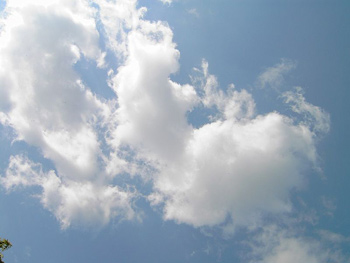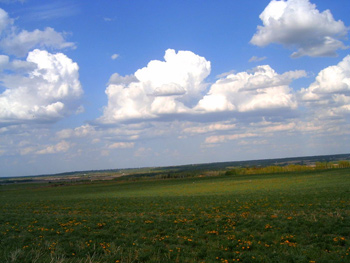
Source: Daisy chain, Ecrips, Wikimedia
A stanza in poetry is like a paragraph in prose. Often the lines in a stanza will have a specific rhyme scheme or arrangement. In this stanza from Shel Silverstein’s poem “Whatif,” the first and second lines rhyme with each other, as do the third and fourth lines. We identify this scheme or arrangement as AABB.
Last night, while I lay thinking here, A
some Whatifs crawled inside my ear A
and pranced and partied all night long B
and sang their same old Whatif song: B
Lines ending with similar sounds are highlighted in yellow and are marked A. Lines ending with similar sounds, but different sounds than the first set, are highlighted in blue and are marked B.
ABAB indicates another rhyme scheme: a four-line stanza in which the first and third lines rhyme, as do the second and fourth lines. The lines below are taken from Alfred, Lord Tennyson’s “Crossing the Bar” and show an ABAB rhyme scheme. Again, lines ending with similar sounds are highlighted in yellow and are marked A. Lines ending with similar sounds, but different sounds than the first set, are highlighted in blue and are marked B.
Twilight and evening bell, A
And after that the dark! B
And may there be no sadness of farewell, A
When I embark; B
Many variations of rhyme schemes exist. To identify a rhyme scheme, follow these two simple steps:
- Assign a capital letter (A, B, C, D, etc.) to each new sound at the end of a line.
I wandered lonely as a cloud A
That floats on high o’er vales and hills, B
- If the sound repeats, assign the same letter.

Source: Skyer meteorologisk, da Bruger: Glenn, Wikimedia
I wandered lonely as a cloud A
That floats on high o’er vales and hills, B
When all at once I saw a crowd, A
A host, of golden daffodils; B
The rhyme scheme in the four lines above from William Wordsworth’s “I Wandered Lonely as a Cloud” is an example of an ABAB rhyme scheme. The stanza actually contains two more lines.
Question: How would you label the last two lines? Think of your answers. Then, check your understanding.

Source: Alberta clouds 044, Glenlarson, Wikimedia,
I wandered lonely as a cloud A
That floats on high o’er vales and hills, B
When all at once I saw a crowd, A
A host, of golden daffodils; B
Beside the lake, beneath the trees,
Fluttering and dancing in the breeze.
Sample Responses
If you said C, you’re absolutely correct. “[T]rees” at the end of the 5th line repeats neither the sound labeled A (“cloud,” “crowd”) nor the sound labeled B (“hills,” “daffodils”). Therefore, the next letter in the alphabet, C, is assigned to this line. The last word in the 6th line, “breeze,” rhymes with “trees,” so this line is also marked C.
Can you mark the rhyme scheme of the next two stanzas of Wordsworth’s poem? Drag and drop the appropriate letter for each line. Hint: Label the first line of each stanza A.

Question: Now that you have had some practice with rhyme scheme, see if you can predict the last word in each stanza of Shel Silverstein’s poem “Whatifs.” Think of your answers. Then, check your understanding to see a possible response.

Source: La tela, marifir, Flickr
Whatif I’m dumb in school?
Whatif they’ve closed the swimming pool?
Whatif I get beat up?
Whatif there’s poison in my ___________?
Whatif I start to cry?
Whatif I get sick and die?
Whatif I flunk that test?
Whatif green hair grows on my _________?
Sample Responses
If you predicted “cup” as the last word in the first stanza above and “chest” as the last word in the second stanza, you’re definitely an expert on rhyme scheme. Both stanzas exemplify an AABB arrangement.